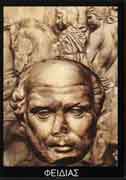Who was Onomarchus?
This part of the history and background of Phillips martial activities is crowded in conflict. The City States were scheming, at each was at the other throat or bribing someone on a regular basis. During Phillips rise, he was embroiled in the activities of the Third Sacred War.
From the Wiki:

The Third Sacred War (356 BC–346 BC) was fought between the forces of the Delphic Amphictyonic League, principally represented by Thebes, and latterly by Philip II of Macedon, and the Phocians. The war was caused by a large fine imposed in 357 BC on the Phocians by the Amphictyonic League (dominated at that moment by Thebes), for the offence of cultivating sacred land; refusing to pay, the Phocians instead seized the Temple of Apollo in Delphi, and used the accumulated treasures to fund large mercenary armies.
Back to Onomarchus (Greek: Ονόμαρχος) was general of the Phocians in the Third Sacred War, brother of Philomelus and son of Theotimus.
Onomarchus commanded a division of the Phocian army under Philomelus in the action at Tithorea, in which Philomelus perished. After the battle Onomarchus gathered the remains of the Phocian army and retreated to Delphi. An assembly of the people was held, in which Onomarchus strongly urged the prosecution of the war — in opposition to the counsels of the more moderate party — and succeeded in obtaining his own nomination to the chief command in the place of Philomelus 353 BC.

Onomarchus was, however, far from imitating the moderation of his predecessor: he confiscated the property of all those who were opposed to him and scrupulously squandered the sacred treasures of Delphi. Using the treasures of Delphi he was able to assemble and maintain a large body of mercenary troops, in addition to bribing many of the hostile states, allowing him to influence the Thessalians to abandon their allies and take up a neutral position.
Thus freed from his most formidable antagonists, he was more than a match for his remaining foes.
Following the siege of Chaeronea, his assistance was requested by Lycophron, a tyrant of Pherae who was attacked by Philip II of Macedon. At first Onomarchus sent his brother Phayllus into Thessaly with an army of 7000 men, to a defeat by Philip’s armies. Onomarchus then marched with his whole forces to the support of Lycophron, defeated Philip in two successive battles, and drove him out of Thessaly.

Onomarchus then returned to Boeotia, whom he defeated in a battle, and took the city of Coroneia. He was then recalled once more to the assistance of Lycophron, against Philip, who had again invaded Thessaly.
Onomarchus hastened to support his ally with an army of 20,000 foot and 500 horse, but was met by Philip at the head of a force, still more numerous, and a pitched battle ensued, in which the superiority of the Thessalian cavalry decided the victory in favour of Philip.
Onomarchus and many of the fugitives plunged into the sea in hopes of swimming to the Athenian ships under Chares which were lying off the shore, but perished in the waves, or, according to Pausanias, by the darts of his own soldiers. Onomarchus’ body fell into the hands of Philip, who had it crucified as punishment for his sacrilege. His death took place in 352 BC.
This is where we pick up Phillip II story as we experience his Rise over Macedon.
One thought on “Battle of Coronea 353 B.C.”
Comments are closed.